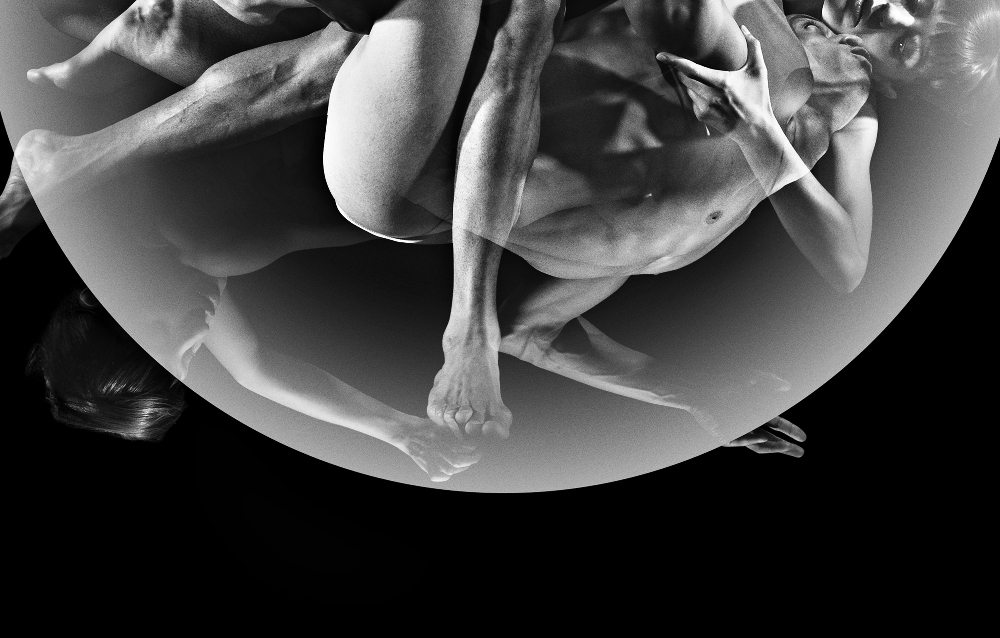Some choreographers get turned on by stories; others by music; yet others by the unpredictable magic of rehearsal room chemistry between dancers. Wayne McGregor, the shaven-headed, lanky, black clad superstar of British contemporary ballet, apparently needs a few research scientists, and a question philosophers have been trying to answer for three thousand years: what is a body?
This is the question heading up the programme notes for Atomos, the new piece by McGregor and Random Dance which had its world premiere at Sadler’s Wells last night. Helping McGregor and his dancers to answer it were live, digitally-manipulated music by A Winged Victory for the Sullen, lighting design by longtime McGregor collaborator Lucy Carter, and costumes that had been 3D printed (not that I could tell from looking at them) by Studio XO, self-declared “pioneers in ‘the internet of everything’ for the body”.
The palette of 'Atomos' is that of 1950s science-fiction - mauve, sand, burgundy, black and fluorescent green
First, let me say, each to their own; I’m genuinely pleased for McGregor that his high profile and commercial success enable him to work exactly the way he wants to with Random Dance. I admire him, too, for his restless need to question his own practices, and for the dedication with which he pursues collaborations with cognitive scientists, develops computer aids to choreography (what was previously the Choreographic Thinking Tool now seems to be a 3D “interactive digital object” which looks like a robot but moves like a human), and constantly imagines new ways to transform moments of inspiration into dance.
And yet, if you watch Atomos with its framing inquiry in mind – if you seek out interviews with McGregor, visit the exhibition, or read the programme notes – you will not be any closer to answering the original question, what is a body? Nor – crucially – will you enjoy the production any more than if you came at it quite uninformed. The wrapping of talk that McGregor’s creations come swathed in is (much like the 3D glasses given to audience members at the beginning of Atomos) a befuddling and unnecessary distraction from what is truly, breathtakingly, excellent: the dancing.
The ten dancers who make up Random Dance are by all measures superb – you won’t see better outside a major national company. For the seventy-five minutes of Atomos they are on stage almost constantly, and their bodies are bent, stretched, twisted, inverted and spun around by choreography that demands relentless energy and focus. McGregor’s instantly recognisable choreographic language combines the free movement grammar of contemporary dance with the sinuous grace and long extensions of ballet – a particularly exhausting combination for dancers to nail because it requires total fluidity and total control, as well as the ability to do things wrong while still looking right.

McGregor loves to bring his dancers out of turns in a counter-intuitive direction or to shatter and reassemble classical movement sequences. A striking example in Atomos is a pas de deux set over a cello solo. The situation is classical, but the movement cannot stay that way – arms are held up in fifth, then dive to the floor, while a developpé à la seconde is interrupted by a partner coming from behind at the most un-balletic waist level.
Random's dancers rise to such challenges with ease, but finding the emotional resonance to match this technical mastery proves a little trickier. Real human encounters, snapshots of tenderness or sadness or friendship between two or three dancers, are good, but disappointingly brief, in Atomos, flickering across the stage like the abstract, pixellated images displayed on seven screens above the dancers’ heads. We had better luck with group scenes: from the opening tableau of all ten dancers softly undulating in a pool of light, like seaweed rippling in clear water, every appearance of the whole company on stage was marked by increased energy, warmth and purpose.
The impression it left was unfortunately a little atomized
In part I think that is because the visual design feels most complete when all the dancers are present. The palette of Atomos is that of 1950s science-fiction – mauve, sand, burgundy, black and fluorescent green – and it is represented only partially on each dancer’s costume; only when all are on stage do the elements cohere into a whole, with the seemingly random undulating lines on each leotard setting up a visual resonance between the dancers that made them far more intelligible as a group than as discrete individuals.
At several points in Atomos, the music sounds like the low, amplified ringing of bronze bells, and in a way that summed up the whole experience for me: a sensually powerful reverberation that nevertheless quickly dies away. When you are inside it, Atomos is an immersive sensory experience, but no amount of technology or visual harmony can make up for the lack of a unifying emotional arc. McGregor’s quest to take apart every small impulse or inspiration that goes into creating a dance work may lead to interesting collaborations, and to a more cerebrally gratifying experience for dancers and choreographer, but the impression it left was unfortunately – and perhaps predictably – a little atomized.
Watch Wayne McGregor talking about the choreographic processes behind Atomos














Add comment